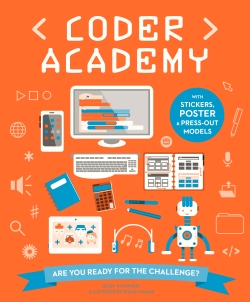 Code Academy by Sean McManus, illustrated by Rosan Magar.
Code Academy by Sean McManus, illustrated by Rosan Magar.
Ivy Kids / Quarto Publishing, £9.99
This is an intriguing new book to introduce coding to children – there’s no guided age on the back but I think it should appeal to KS2 / 9-11 year olds.
It is beautifully designed, with a good clear layout and attractive illustrations by Rosan Magar. It has a press-out cardboard robot in the front flap, a game poster and stickers at the back that the reader can award themselves as they progress through the exercises. This does make it less useful as a school library text book – it is designed to be written in and each section ends with a certificate that you award yourself. It would, however, make a good present for a child curious about technology and probably work best with a parent or older sibling working through it.
Topics covered include an overview of programming languages, the binary number system, Scratch and HTML, with a welcome emphasis on Scratch. The binary section is short, but strikes me as being a bit odd – it doesn’t really go anywhere and breaks up the flow of the book which builds nicely in the Scratch section through different concepts such as co-ordinates, loops, variables, selection, sprite design and music. I don’t think the binary section would be missed if it were dropped.
I think the focus on Scratch (free, child-centred, widely-supported, works on many devices) is an excellent idea, and I like the inclusion of a section on flowcharts to plan a number guessing game before coding it. It takes the reader through animation, sprite design, planning and making music in a good progression that should be easy to follow and make projects increasingly exciting for children. There is also a web site to offer support where code can be downloaded if readers get stuck.
The chapter on HTML covers the most basic tags, and progresses to add colour using hexadecimal colour codes, which is a nice idea, although it doesn’t explain why #FF0000 is red, #00FF00 is blue etc. This seems like a bit of a missed opportunity to demystify the hex numbers and explain a bit of physics at the same time. Although Javascript is mentioned at the start of the book, there’s no Javascript coding activity in the book, which might have made the HTML a bit more exciting; lack of space and the book’s scope may have made this not possible but its inclusion might have expanded the appeal of the book.
In summary, a well-designed and well-written introduction to coding which could inspire primary-aged children to study computer science in later years, and it will provide a good support to school studies of computing. A timely release for anyone looking for a seasonal gift for a technologically-curious but inexperienced child, grand-child, niece – or for a school prize!
